technical specifications FIAT DOBLO COMBI 2013 Owner handbook (in English)
[x] Cancel search | Manufacturer: FIAT, Model Year: 2013, Model line: DOBLO COMBI, Model: FIAT DOBLO COMBI 2013Pages: 283, PDF Size: 6.31 MB
Page 189 of 283
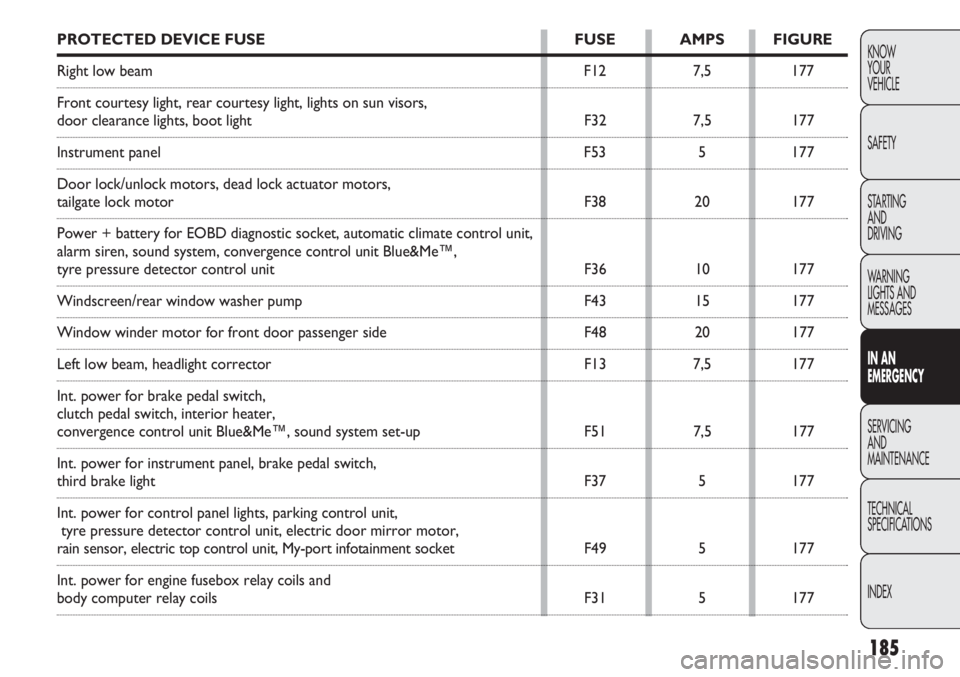
185
KNOW
YOUR
VEHICLE
SAFETY
STARTING
AND
DRIVING
WARNING
LIGHTS AND
MESSAGES
IN AN
EMERGENCY
SERVICING
AND
MAINTENANCE
TECHNICAL
SPECIFICATIONS
INDEXPROTECTED DEVICE FUSE FUSE AMPS FIGURE
Right low beam F127,5177
Front courtesy light, rear courtesy light, lights on sun visors,
door clearance lights, boot light F327,5177
Instrument panel F535177
Door lock/unlock motors, dead lock actuator motors,
tailgate lock motor F3820177
Power + battery for EOBD diagnostic socket, automatic climate control un\
it,
alarm siren, sound system, convergence control unit Blue&Me™,
tyre pressure detector control unit F3610177
Windscreen/rear window washer pump F4315177
Window winder motor for front door passenger side F4820177
Left low beam, headlight corrector F137,5177
Int. power for brake pedal switch,
clutch pedal switch, interior heater,
convergence control unit Blue&Me™, sound system set-up F517,5177
Int. power for instrument panel, brake pedal switch,
third brake light F375177
Int. power for control panel lights, parking control unit, tyre pressure detector control unit, electric door mirror motor,
rain sensor, electric top control unit, My-port infotainment socket F495177
Int. power for engine fusebox relay coils and
body computer relay coils F315177
Page 191 of 283
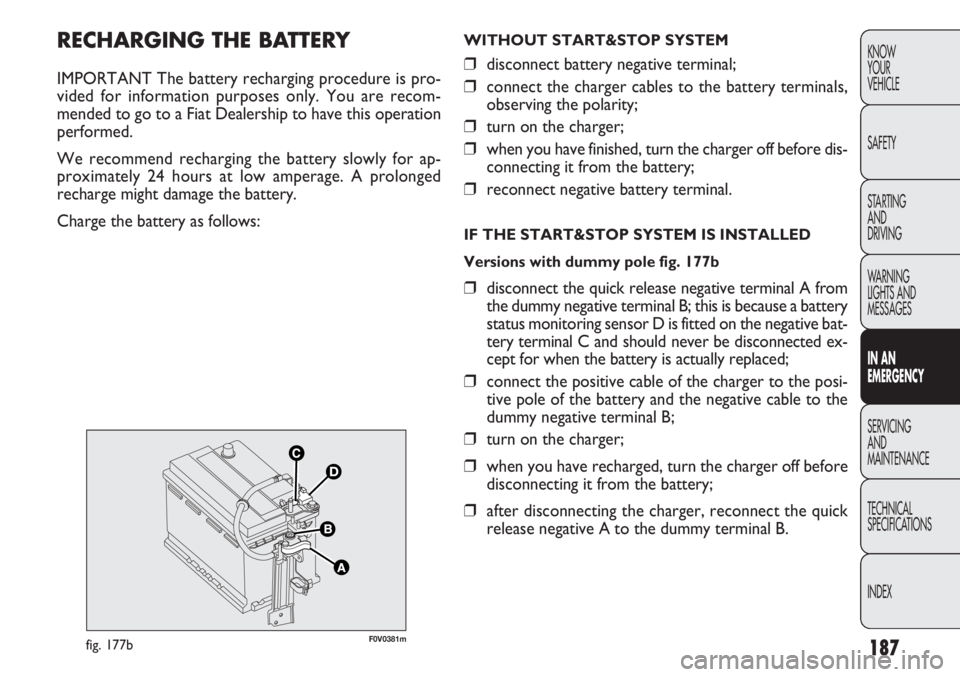
187
KNOW
YOUR
VEHICLE
SAFETY
STARTING
AND
DRIVING
WARNING
LIGHTS AND
MESSAGES
IN AN
EMERGENCY
SERVICING
AND
MAINTENANCE
TECHNICAL
SPECIFICATIONS
INDEXRECHARGING THE BAT T ERY
IMPORTANT The battery recharging procedure is pro-
vided for information purposes only. You are recom-
mended to go to a Fiat Dealership to have this operation
performed.
We recommend recharging the battery slowly for ap-
proximately 24 hours at low amperage. A prolonged
recharge might damage the battery.
Charge the battery as follows:
F0V0381mfig. 177b
WITHOUT START&STOP SYSTEM
❒disconnect battery negative terminal;
❒ connect the charger cables to the battery terminals,
observing the polarity;
❒ turn on the charger;
❒ when you have finished, turn the charger off before dis-
connecting it from the battery;
❒ reconnect negative battery terminal.
IF THE START&STOP SYSTEM IS INSTALLED
Versions with dummy pole fig. 177b
❒disconnect the quick release negative terminal A from
the dummy negative terminal B; this is because a battery
status monitoring sensor D is fitted on the negative bat-
tery terminal C and should never be disconnected ex-
cept for when the battery is actually replaced;
❒ connect the positive cable of the charger to the posi-
tive pole of the battery and the negative cable to the
dummy negative terminal B;
❒ turn on the charger;
❒ when you have recharged, turn the charger off before
disconnecting it from the battery;
❒ after disconnecting the charger, reconnect the quick
release negative A to the dummy terminal B.
Page 193 of 283
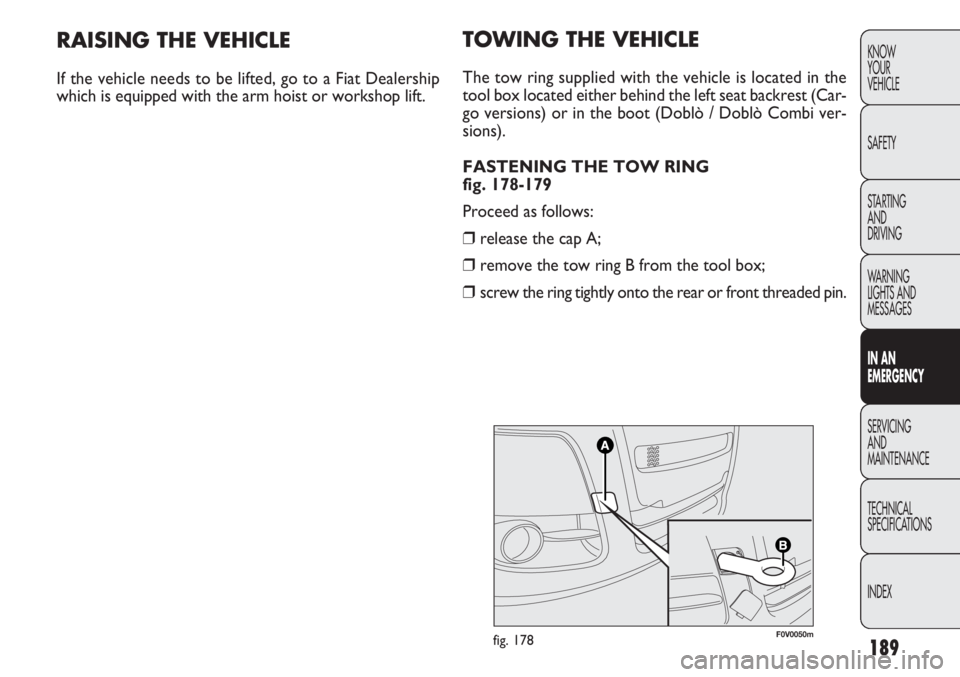
189
KNOW
YOUR
VEHICLE
SAFETY
STARTING
AND
DRIVING
WARNING
LIGHTS AND
MESSAGES
IN AN
EMERGENCY
SERVICING
AND
MAINTENANCE
TECHNICAL
SPECIFICATIONS
INDEXTOWING THE VEHICLE
The tow ring supplied with the vehicle is located in the
tool box located either behind the left seat backrest (Car-
go versions) or in the boot (Doblò / Doblò Combi ver-
sions).
FASTENING THE TOW RING
fig. 178-179
Proceed as follows:
❒ release the cap A;
❒ remove the tow ring B from the tool box;
❒ screw the ring tightly onto the rear or front threaded pin.
F0V0050mfig. 178
RAISING THE VEHICLE
If the vehicle needs to be lifted, go to a Fiat Dealership
which is equipped with the arm hoist or workshop lift.
Page 197 of 283
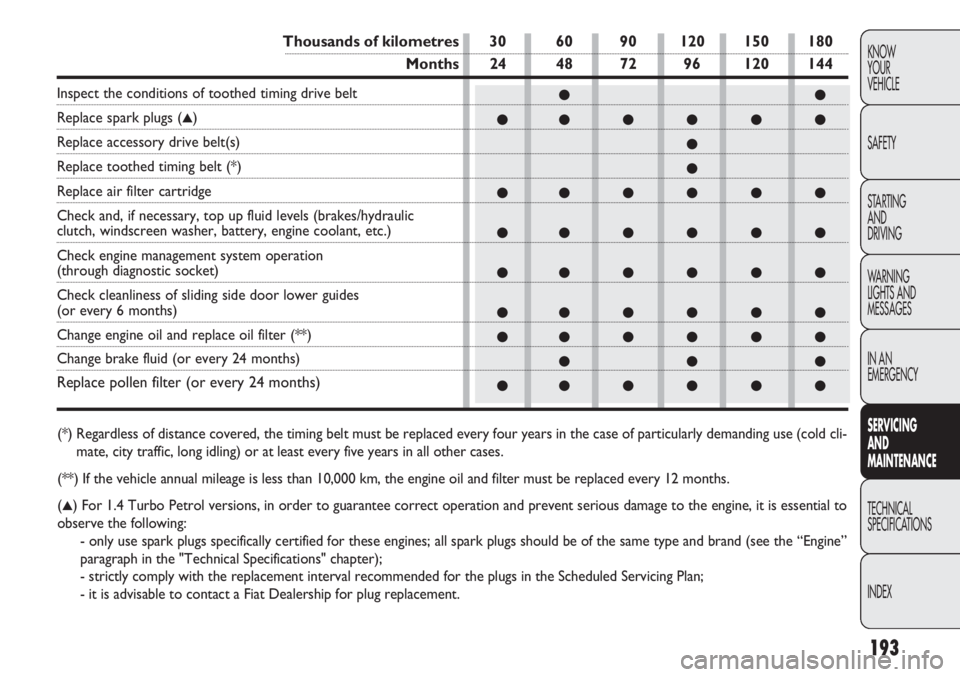
193
KNOW
YOUR
VEHICLE
SAFETY
STARTING
AND
DRIVING
WARNING
LIGHTS AND
MESSAGES
IN AN
EMERGENCY
SERVIC
ING
AND
MAINTENANCE
TECHNICAL
SPECIFICA TIONS
INDEX
●●
●●●●●●
●
●
●●●●●●
●●●●●●
●●●●●●
●●●●●●
●●●●●● ●●●
●●●●●●
Thousands of kilometres 30 60 90 120 150 180
Months 24 48 72 96 120 144
Inspect the conditions of toothed timing drive belt
Replace spark plugs (▲)
Replace accessory drive belt(s)
Replace toothed timing belt (*)
Replace air filter cartridge
Check and, if necessary, top up fluid levels (brakes/hydraulic
clutch, windscreen washer, battery, engine coolant, etc.)
Check engine management system operation
(through diagnostic socket)
Check cleanliness of sliding side door lower guides
(or every 6 months)
Change engine oil and replace oil filter (**)
Change brake fluid (or every 24 months)
Replace pollen filter (or every 24 months)
(*) Regardless of distance covered, the timing belt must be replaced every f\
our years in the case of particularly demanding use (cold cli-
mate, city traffic, long idling) or at least every five years in all ot\
her cases.
(**) If the vehicle annual mileage is less than 10,000 km, the engine oil and\
filter must be replaced every 12 months.
(
▲) For 1.4 Turbo Petrol versions, in order to guarantee correct operatio\
n and prevent serious damage to the engine, it is essential to
observe the following: - only use spark plugs specifically certified for these engines; all spa\
rk plugs should be of the same type and brand (see the “Engine”
paragraph in the "Technical Specifications" chapter);
- strictly comply with the replacement interval recommended for the plug\
s in the Scheduled Servicing Plan;
- it is advisable to contact a Fiat Dealership for plug replacement.
Page 209 of 283
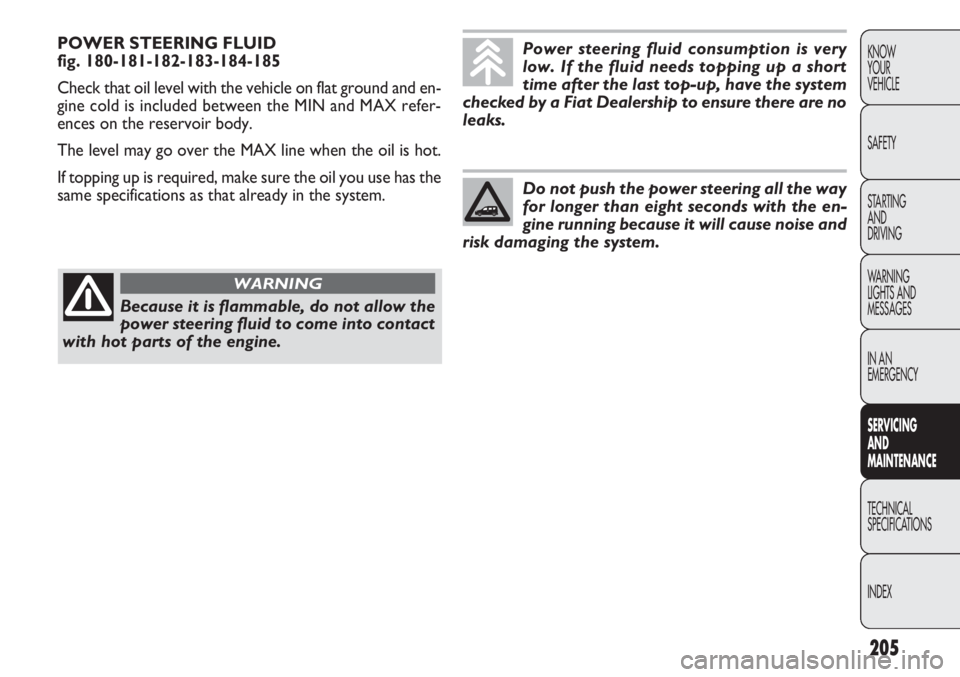
205
KNOW
YOUR
VEHICLE
SAFETY
STARTING
AND
DRIVING
WARNING
LIGHTS AND
MESSAGES
IN AN
EMERGENCY
SERVIC
ING
AND
MAINTENANCE
TECHNICAL
SPECIFICA TIONS
INDEX
POWER STEERING FLUID
fig. 180-181-182-183-184-185
Check that oil level with the vehicle on flat ground and en-
gine cold is included between the MIN and MAX refer-
ences on the reservoir body.
The level may go over the MAX line when the oil is hot.
If topping up is required, make sure the oil you use has the
same specifications as that already in the system.Power steering fluid consumption is very
low. If the fluid needs topping up a short
time after the last top-up, have the system
checked by a Fiat Dealership to ensure there are no
leaks.
Do not push the power steering all the way
for longer than eight seconds with the en-
gine running because it will cause noise and
risk damaging the system.
Because it is flammable, do not allow the
power steering fluid to come into contact
with hot parts of the engine.
WARNING
Page 211 of 283
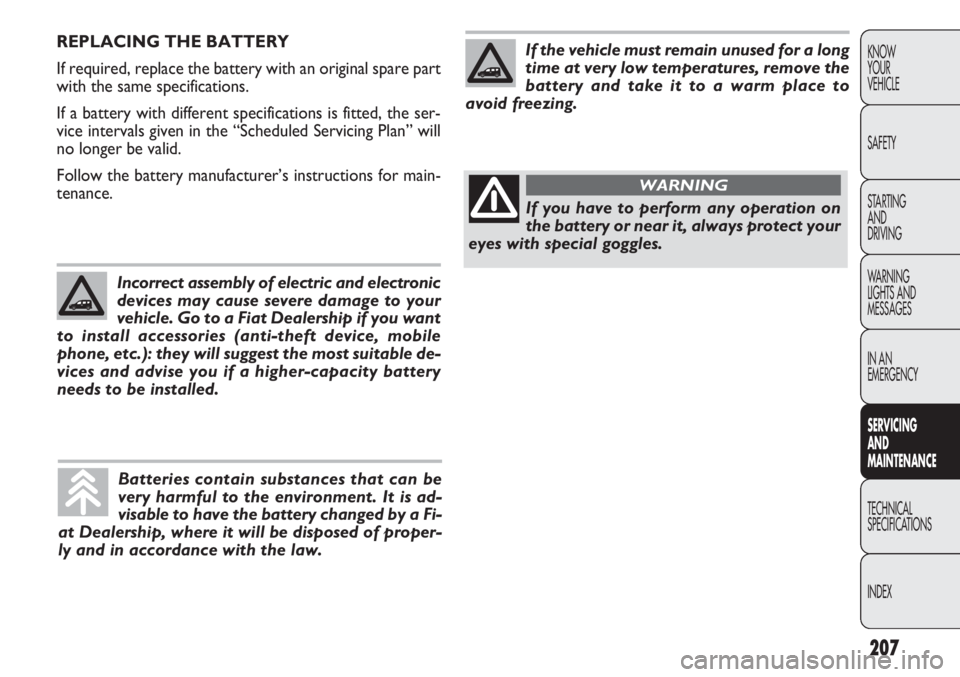
207
KNOW
YOUR
VEHICLE
SAFETY
STARTING
AND
DRIVING
WARNING
LIGHTS AND
MESSAGES
IN AN
EMERGENCY
SERVIC
ING
AND
MAINTENANCE
TECHNICAL
SPECIFICA TIONS
INDEX
REPLACING THE BATTERY
If required, replace the battery with an original spare part
with the same specifications.
If a battery with different specifications is fitted, the ser-
vice intervals given in the “Scheduled Servicing Plan” will
no longer be valid.
Follow the battery manufacturer’s instructions for main-
tenance.
Incorrect assembly of electric and electronic
devices may cause severe damage to your
vehicle. Go to a Fiat Dealership if you want
to install accessories (anti-theft device, mobile
phone, etc.): they will suggest the most suitable de-
vices and advise you if a higher-capacity battery
needs to be installed.
Batteries contain substances that can be
very harmful to the environment. It is ad-
visable to have the battery changed by a Fi-
at Dealership, where it will be disposed of proper-
ly and in accordance with the law.
If the vehicle must remain unused for a long
time at very low temperatures, remove the
battery and take it to a warm place to
avoid freezing.
If you have to perform any operation on
the battery or near it, always protect your
eyes with special goggles.
WARNING
Page 213 of 283
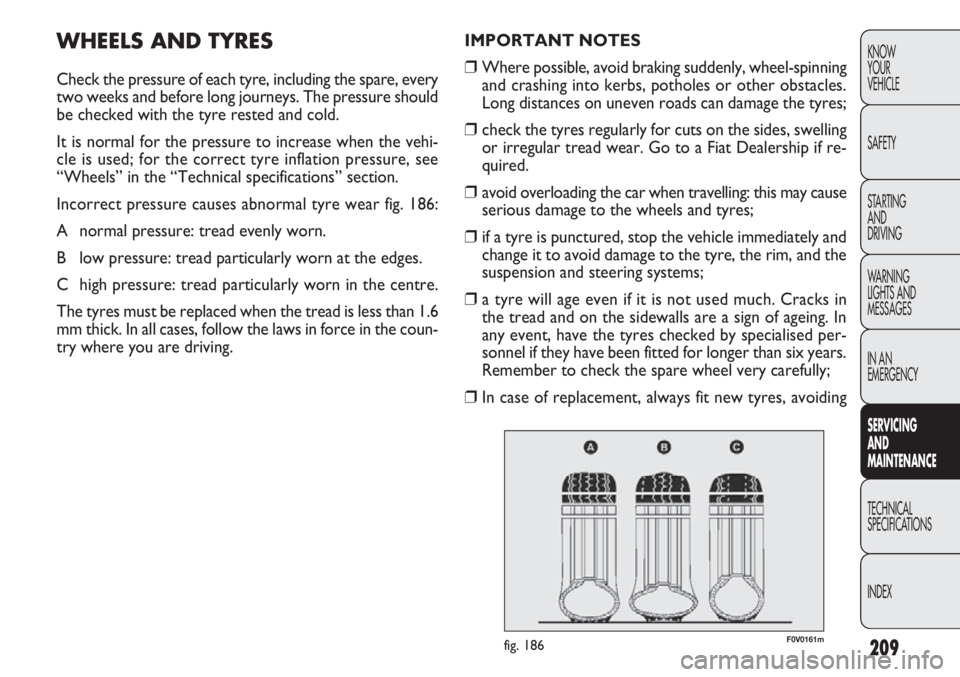
209
KNOW
YOUR
VEHICLE
SAFETY
STARTING
AND
DRIVING
WARNING
LIGHTS AND
MESSAGES
IN AN
EMERGENCY
SERVIC
ING
AND
MAINTENANCE
TECHNICAL
SPECIFICA TIONS
INDEX
IMPORTANT NOTES
❒ Where possible, avoid braking suddenly, wheel-spinning
and crashing into kerbs, potholes or other obstacles.
Long distances on uneven roads can damage the tyres;
❒ check the tyres regularly for cuts on the sides, swelling
or irregular tread wear. Go to a Fiat Dealership if re-
quired.
❒ avoid overloading the car when travelling: this may cause
serious damage to the wheels and tyres;
❒ if a tyre is punctured, stop the vehicle immediately and
change it to avoid damage to the tyre, the rim, and the
suspension and steering systems;
❒ a tyre will age even if it is not used much. Cracks in
the tread and on the sidewalls are a sign of ageing. In
any event, have the tyres checked by specialised per-
sonnel if they have been fitted for longer than six years.
Remember to check the spare wheel very carefully;
❒ In case of replacement, always fit new tyres, avoidingWHEELS AND TYRES
Check the pressure of each tyre, including the spare, every
two weeks and before long journeys. The pressure should
be checked with the tyre rested and cold.
It is normal for the pressure to increase when the vehi-
cle is used; for the correct tyre inflation pressure, see
“Wheels” in the “Technical specifications” section.
Incorrect pressure causes abnormal tyre wear fig. 186:
A normal pressure: tread evenly worn.
B low pressure: tread particularly worn at the edges.
C high pressure: tread particularly worn in the centre.
The tyres must be replaced when the tread is less than 1.6
mm thick. In all cases, follow the laws in force in the coun-
try where you are driving.
F0V0161mfig. 186
Page 218 of 283
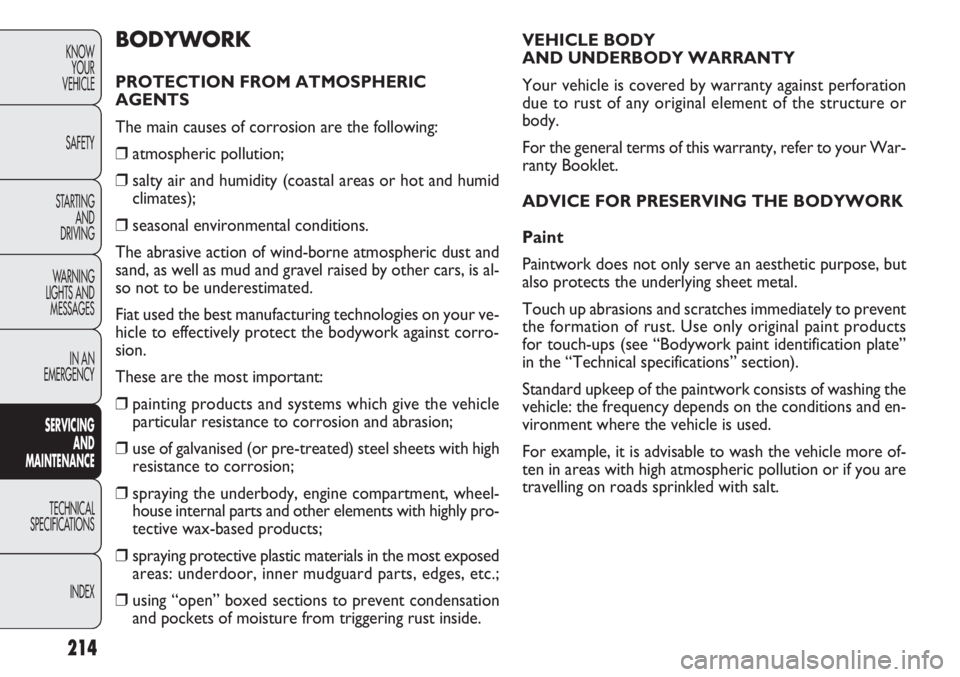
214
KNOWYOUR
VEHICLE
SAFETY
STARTING AND
DRIVING
WARNING
LIGHTS AND MESSAGES
IN AN
EMERGENCY
SERV IC
ING
AND
MAINTENANCE
TECHNICAL
SPECIFICA TIONS
INDEX
VEHICLE BODY
AND UNDERBODY WARRANTY
Your vehicle is covered by warranty against perforation
due to rust of any original element of the structure or
body.
For the general terms of this warranty, refer to your War-
ranty Booklet.
ADVICE FOR PRESERVING THE BODYWORK
Paint
Paintwork does not only serve an aesthetic purpose, but
also protects the underlying sheet metal.
Touch up abrasions and scratches immediately to prevent
the formation of rust. Use only original paint products
for touch-ups (see “Bodywork paint identification plate”
in the “Technical specifications” section).
Standard upkeep of the paintwork consists of washing the
vehicle: the frequency depends on the conditions and en-
vironment where the vehicle is used.
For example, it is advisable to wash the vehicle more of-
ten in areas with high atmospheric pollution or if you are
travelling on roads sprinkled with salt.BODYWORK
PROTECTION FROM ATMOSPHERIC
AGENTS
The main causes of corrosion are the following:
❒ atmospheric pollution;
❒ salty air and humidity (coastal areas or hot and humid
climates);
❒ seasonal environmental conditions.
The abrasive action of wind-borne atmospheric dust and
sand, as well as mud and gravel raised by other cars, is al-
so not to be underestimated.
Fiat used the best manufacturing technologies on your ve-
hicle to effectively protect the bodywork against corro-
sion.
These are the most important:
❒ painting products and systems which give the vehicle
particular resistance to corrosion and abrasion;
❒ use of galvanised (or pre-treated) steel sheets with high
resistance to corrosion;
❒ spraying the underbody, engine compartment, wheel-
house internal parts and other elements with highly pro-
tective wax-based products;
❒ spraying protective plastic materials in the most exposed
areas: underdoor, inner mudguard parts, edges, etc.;
❒ using “open” boxed sections to prevent condensation
and pockets of moisture from triggering rust inside.
Page 223 of 283
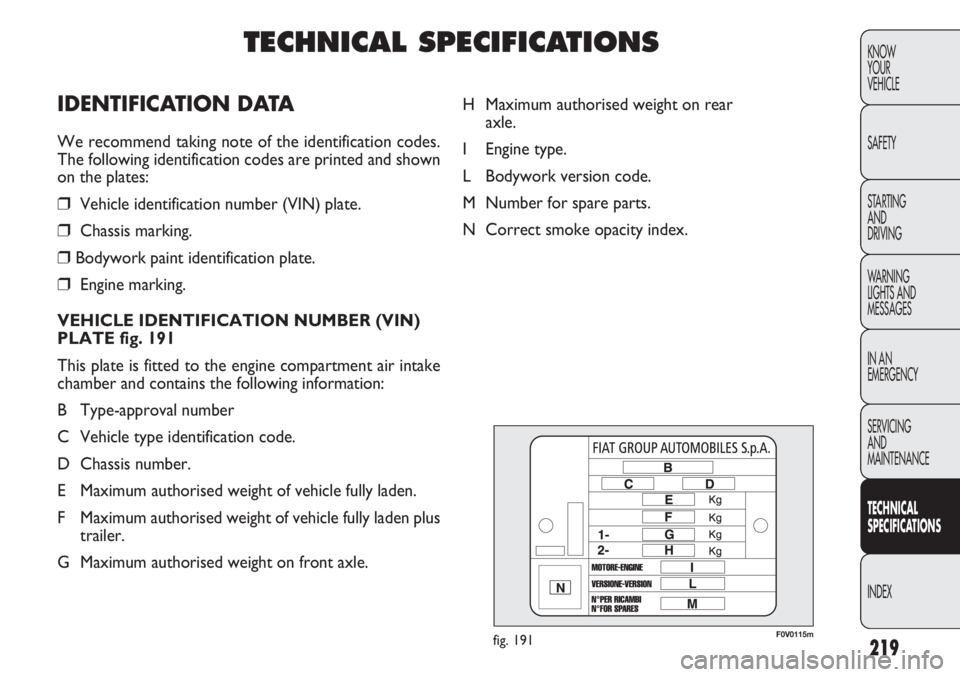
219
KNOW
YOUR
VEHICLE
SAFETY
STARTING
AND
DRIVING
WARNING
LIGHTS AND
MESSAGES
IN AN
EMERGENCY
SERVICING
AND
MAINTENANCE
TECHNICAL
SPECIFICATIO
NS
INDEX
F0V0115mfig. 191
H Maximum authorised weight on rear axle.
I Engine type.
L Bodywork version code.
M Number for spare parts.
N Correct smoke opacity index.
TECHNICAL SPECIFICATIONS
IDENTIFICAT I ON DATA
We recommend taking note of the identification codes.
The following identification codes are printed and shown
on the plates:
❒Vehicle identification number (VIN) plate.
❒Chassis marking.
❒Bodywork paint identification plate.
❒Engine marking.
VEHICLE IDENTIFICATION NUMBER (VIN)
PLATE fig. 191
This plate is fitted to the engine compartment air intake
chamber and contains the following information:
B Type-approval number
C Vehicle type identification code.
D Chassis number.
E Maximum authorised weight of vehicle fully laden.
F Maximum authorised weight of vehicle fully laden plus trailer.
G Maximum authorised weight on front axle.
Page 228 of 283
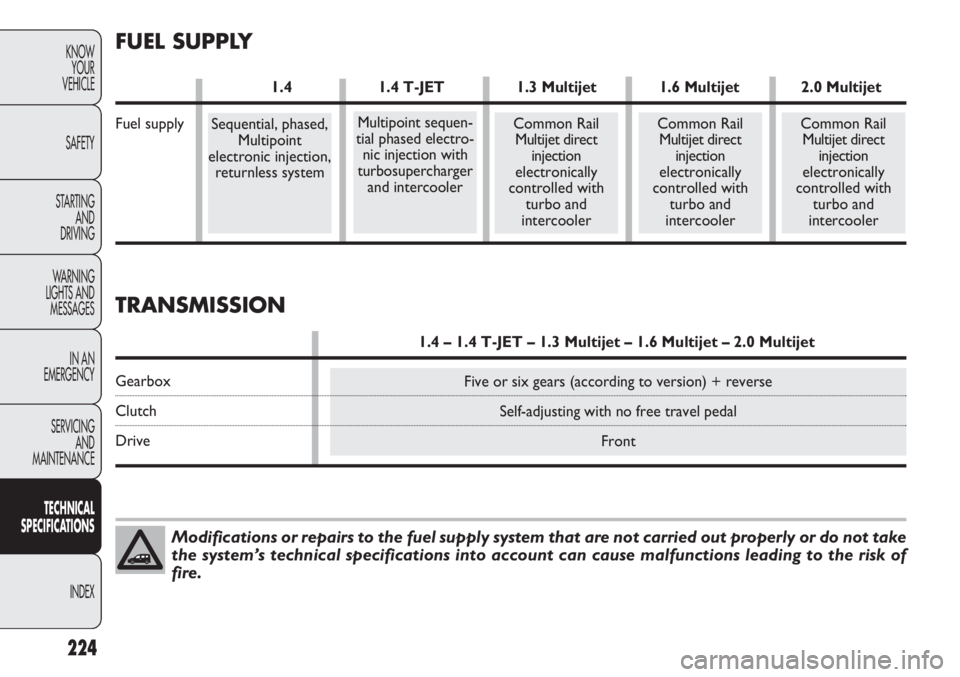
224
KNOWYOUR
VEHICLE
SAFETY
STARTING AND
DRIVING
WARNING
LIGHTS AND MESSAGES
IN AN
EMERGENCY
SERVICING AND
MAINTENANCE
TECHNICAL
SPECIFICAT IO
NS
INDEX
Modifications or repairs to the fuel supply system that are not carried \
out properly or do not take
the system’s technical specifications into account can cause malfunct\
ions leading to the risk of
fire.
Sequential, phased, Multipoint
electronic injection, returnless systemCommon Rail Multijet direct injection
electronically
controlled with turbo and
intercoolerCommon Rail Multijet direct injection
electronically
controlled with turbo and
intercoolerCommon Rail Multijet direct injection
electronically
controlled with turbo and
intercooler
Five or six gears (according to version) + reverse
Self-adjusting with no free travel pedal Front
TRANSMISSION
1.4 – 1.4 T-JET – 1.3 Multijet – 1.6 Multijet – 2.0 Multijet
Gearbox
Clutch
Drive
Multipoint sequen-
tial phased electro- nic injection with
turbosupercharger and intercooler
FUEL SUPPLY
1.4 1.4 T-JET 1.3 Multijet 1.6 Multijet 2.0 Multijet
Fuel supply